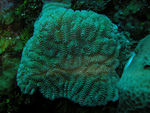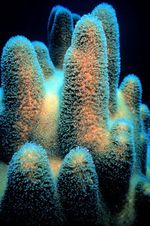Meandrinidae
| Meandrinidae |
|---|

|
| Scientific Classification |
|
| Genera |
The family Meandrinidae contains 9 species of coral ranging from Elliptical Star Coral to Maze Coral to Pillar Coral and many others. These corals live in tropical warm waters such as the Caribbean, Indian Ocean, and even some in the Red Sea. The diverse designs of these corals makes them unique and pleasing to the eye. The overall rarity of seeing them makes them not so popular to tourists and harder for scientists to study. Despite the diversity they all live the same lifestyle and are essentially the same.
Body Design
Members of the family Meandrinidae can be recognized as corals with solid pillars. They grow as immense column-like structure. Most Meandrinidae have similar outside structures to the family Faviidae. The surface of Meandrinidae is non porous, unlike the family Faviidae (Brain Corals) and most other corals. A hemisphere-like shape is exhibited by most of the corals in this family. The Dendrogyra cylindrus is most noted for its different pillar-like formations ranging from 2 m to 3 m high.[2] Colors range everywhere from green and brown tints, to pink and green tints.[3]
All the genera are meandroid, which means the corallites (the skeleton of a single coral polyp) form continuous raised lines with a valley like ditch in-between, except the genera Eusmilia. The ditches of the meandroid corals are usually about 1 cm deep and 1.5 cm from ridge to ridge. Eusmilia contains a round phaceloid structure, which means the corallites extend from the base to form tall corallites.[2] Also, septa, inside edge of a corallite, are soft; unlike the hard structures of the other genera in the family Meandrinidae.[4]
Life Cycle
Organisms within the family Meandrinidae are gonochorous which means there are two distinct genders. The only spawning season for Dichocoenia stokesi known for certain is late August to early September or October. For Dichocoenia stokesi coral, the average egg size measured was 312.2 μm. The smallest colony observed reproducing was 160 cm squared. Not much is known about the larval stage, except that they preform external fertilization because of the population scarcity.
Dichocoenia stokesi grow an average of 2–7 mm in diameter and 2-5.2 mm in height per year. Dendrogyra cylindrus, known as pillar coral, grows 12-20 mm per year, forming a pillar, hence the name. “Adult” corals perform photosynthesis for gathering energy. For this reason corals in the family Meandrinidae live in relatively shallow waters to increase maximum intake of sunlight. The Dichocoenia stokesi also captures prey in addition to performing photosynthesis.[5][6]
Ecology
These corals live in the Atlantic Ocean, primarily in the Caribbean, except for the Ctenella and Gyrosmilia which live in the Indian Ocean.[2] The Gyrosmilia interrupta has been found in the Red Sea, no doubt because of the similar reef formations to the Caribbean. The corals in the family Meandrinidae have one common factor in their habitat, and that is the warm temperature of the water. They live best in temperatures ranging between 73 °F to 81°F which can be found in places such as the Caribbean.[7]
They live in water depths ranging from 1-25 m with a flat or slightly sloped floor. Despite their living conditions on a minimally sloped floor, these corals are located on the fore reef, the reef layer which faces the open ocean. Their population has been greatly reduced, making it difficult for scientists to study them.[8] Dichocoenia stokesi is the ninth most plentiful specimen in the Caribbean region.[6] On the other hand, the others in this family are not so abundant, especially the Dendrogyra cylindrus. It is considered rare, with less than half the amount of colonies per certain area. [5]
Dangers/Threats
One organism in particular, the Dendrogyra cylindrus, has suffered a great reduction in numbers. There are several items which threaten this species starting with itself. This organism has been observed with a weakness in defending itself from diseases, resulting in death to much of its kind. While not being able to protect itself, erosion can significantly change their environment or even erode their support, causing damage to the coral.
Another major threat is hurricanes. With winds up to about 200 mph, hurricanes can easily destroy colonies of corals at a time. In addition, these colonies commonly live in depths from 5-15 m, where the hurricanes can easily reach them. Other changes in the earth’s climate, such as extreme temperatures, can damage the coral. Recently, bleaching by the sun as a result of the thinning of the ozone layer has contributed to the colonies being unable to resist disease.[8][9]
Video
Gallery
References
- ↑ Meandrinidae Wikispecies. Web. Last Accessed 17 December 2013. Unknown Author.
- ↑ 2.0 2.1 2.2 2.3 Family Meandrinidae Universität Salzburg. Web. Last Accessed 17 December 2013. Unknown Author. Cite error: Invalid
<ref>tag; name "biophysics" defined multiple times with different content Cite error: Invalid<ref>tag; name "biophysics" defined multiple times with different content Cite error: Invalid<ref>tag; name "biophysics" defined multiple times with different content - ↑ Corals Coralpedia. Web. Last Accessed 17 December 2013. Unknown Author
- ↑ Eusmilia Fastigiata Coralpedia. Web. Last Accessed 17 December 2013. Unknown Author
- ↑ 5.0 5.1 Genus Dendrogyra NOAA. Web. Last Accessed 14 January 2014. Unknown Author
- ↑ 6.0 6.1 Genus Dichocoenia NOAA. Web. Last Accessed 14 January 2014. Unknown Author
- ↑ Family Meandrinidae Saltcorner. Web. Last Accessed 14 January 2014. Unknown Author
- ↑ 8.0 8.1 Dendrogyra cylindrus IUCN Red List. Web. Last Accessed 14 January 2014. Unknown Author
- ↑ Dendrogyra cylindrus IUCN Red List. Web. Last Accessed 14 January 2014. Unknown Author






